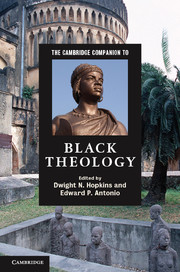Book contents
- Frontmatter
- Part I Introduction
- Part II Themes in black theology
- Part III Global expressions of black theology
- 16 The history of black theology in South Africa
- 17 Black theology in Britain
- 18 Slave religion and black theology in Brazil
- 19 Black theology in Cuba
- 20 Black theology in Jamaica
- 21 Methodology in an Aboriginal theology
- 22 Black theology and postcolonial discourse
- 23 The future of black theology
- Further reading
- Index
- Other titles in the series
21 - Methodology in an Aboriginal theology
from Part III - Global expressions of black theology
Published online by Cambridge University Press: 28 September 2012
- Frontmatter
- Part I Introduction
- Part II Themes in black theology
- Part III Global expressions of black theology
- 16 The history of black theology in South Africa
- 17 Black theology in Britain
- 18 Slave religion and black theology in Brazil
- 19 Black theology in Cuba
- 20 Black theology in Jamaica
- 21 Methodology in an Aboriginal theology
- 22 Black theology and postcolonial discourse
- 23 The future of black theology
- Further reading
- Index
- Other titles in the series
Summary
BLACK THEOLOGY AND ABORIGINAL THEOLOGY
The seeds of contemporary black theology of liberation were nurtured in the USA on July 31, 1966, when the ad hoc National Committee of Negro Churchmen (NCNC) published its “Black Power” statement in the New York Times. Forty-eight black pastors and church administrators in the NCNC from fifteen different denominations and church offices claimed compatibility between Jesus Christ's words and practice and black American culture. Likewise, they asserted a correlation between Jesus' preferential option for the poor and the need for poor and working-class blacks to have power. Restated, Jesus incarnated in black folk culture and revealed himself in black political power.
Similarly, the contemporary foundation for Aboriginal theology (AT) in Australia emerged in the 1960s. Akin to the motivation of black pastors who crafted black theology of liberation, Aboriginal pastors were tired of white (British-descended) churchmen and missionaries telling the indigenous people they were subhuman. Aboriginal people were fed up with white people (mis)speaking with authority on the indigenous people while labeling their culture as primitive and uncivilized.
More positively, in the 1960s a small group of Aboriginal pastors elevated their culture as an authentic site of the ancestors' and Jesus' revelation. And that sacred culture required Aboriginal people to pursue the right of self-determination or political empowerment. Unknown to many outside of Aboriginal communities, these pastors (and many indigenous people today) referred to themselves as black people working with Jesus against structures of white supremacy in the white (British-descended) church in Australia.
- Type
- Chapter
- Information
- The Cambridge Companion to Black Theology , pp. 278 - 297Publisher: Cambridge University PressPrint publication year: 2012
- 1
- Cited by



